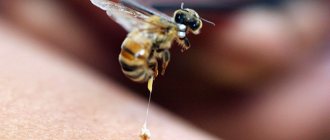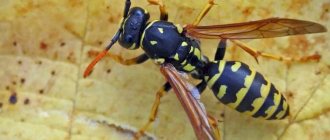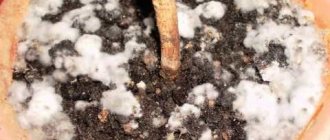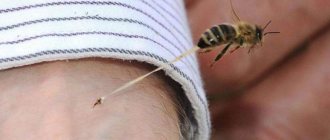Cats, by nature, although small, are predators. Anything that moves can become their prey. Therefore, they hunt not only mice and birds, but also insects. As a result, a situation may arise where a bee stings a cat.
Many animals tolerate this calmly, but sensitive pets may develop anaphylactic shock.
Signs and symptoms
Playing with a bee often ends in a sting. Cats, like people, react negatively to poison entering their body. Standard symptoms include:
- slight swelling or severe swelling at the site of the bite;
- redness;
- itching that the cat tries to relieve by scratching itself with its claws;
- painful sensations.
Swelling
If the lesion is minor, the signs of the bite will go away on their own after a few days, when the toxin is completely eliminated from the body. But it is better to immediately examine your pet to determine exactly where the bee stung the cat. This will help ease his suffering.
- Most often it affects the nose, which immediately swells. In this situation, it is not advisable to wait several days. Due to the swollen spot, the cat can not only eat normally, but also has difficulty breathing.
- The pet may also have difficulty breathing if the bite is on the cheek. The cat begins to wheeze, his heartbeat quickens, and chills appear. The animal feels weak.
- If you notice that your pet is limping, you need to examine its paw. Perhaps this is where the sting got stuck when the cat tried to swat the bee. The animal will try to get rid of the needle by licking the bite site with its tongue. These actions are accompanied by a plaintive meow.
- A cat experiences severe pain when a sting hits its lip. At the same time, it swells, the swelling quickly spreads to the entire muzzle, which becomes disproportionate. To relieve unpleasant symptoms, the animal tries to press its lip against something cold.
- The most dangerous situation is when a bee gets into the oral cavity and stings the cat on the tongue or larynx. The toxin immediately provokes swelling of the nasopharynx, and this swelling causes severe shortness of breath. In this situation, notable signs are excessive salivation and vomiting.
The more toxin that enters the cat’s body, the stronger all these symptoms will appear. Here it is important to provide timely assistance so that serious complications do not arise.
Symptoms of a wasp sting in a cat
In some long-haired breeds (Persian, Angora, etc.), swelling may not be visible due to long hair. Trouble can be suspected by a change in the pet's behavior - it becomes angry, aggressive, does not allow the person who wants to examine it to approach it, and meows pitifully.
INTERESTING TO KNOW: Using Vaseline Oil for Constipation in Cats
In addition to the pain and itching that are characteristic of a stinging insect bite, the owner should be alert to the following symptoms indicating an allergic reaction:
- swelling in a certain place, edema;
- shortness of breath, difficulty breathing;
- vomiting (in some cases);
- increased salivation;
- hyperthermia;
- cardiopalmus;
- chills;
- movement coordination disorder;
- shock;
- loss of consciousness;
- convulsions.
If a wasp sting is suspected and the condition of a cat or dog worsens, the owner should take immediate action.
First aid
If a bee stings, its sting remains in the body. The slightest touch to it increases the pain. Therefore, it is so important to locate the bite site and remove the sting from the cat.
This must be done extremely carefully, otherwise the sting will break and its poisoned tip will remain under the skin. In this case, it is more difficult to remove the fragment. You may even need surgery.
The place where the cat was bitten by a bee is treated with an antiseptic. This will help reduce inflammation. A cold compress is then applied to the swollen area.
Antiseptic
How can you tell if your pet has been bitten?
Naturally, immediately after a bite, the pet experiences severe pain, so the characteristic signs and symptoms of this will be:
- Swelling of the place where the bite occurred.
- General weakness and lethargy appears.
- Salivation increases.
- Rubbing, chewing or licking the bite area.
- Breathing becomes difficult.
- Vomit.
- Blue tongue.
If a dog is stung by a bee, it will begin to whine and howl pitifully, fearing the place where the attack occurred. First, it is necessary to determine the affected area in order to competently take treatment measures.
Don't delay medical help! If your pet has an allergy and you don’t know about it, then the clock will count for its life.
Paws
Compared to other parts of the body, the bite is relatively painless. If the paw is injured, the pet will begin to limp. If the bite was on the pad, then the animals begin to gnaw out the cause of the discomfort. The limb swells almost instantly, and the pet begins to actively lick it.
Muzzle
The most dangerous bee stings for dogs occur in the area of the muzzle and neck, as they lead to serious consequences. If a bee stings a pet on the nose, this will be the most painful place for him. Severe swelling immediately appears in this place, and the animal will behave very pitifully.
It is when the muzzle area is affected that animals develop profuse salivation. Lethargy and fatigue are also characteristic.
If you are bitten in this area, you should immediately take your pet to the veterinarian; if there is no help nearby, try to remove the sting with the bag as quickly as possible so that the poison does not spread further.
Ears
If a sting gets into the ear, the pet will begin to actively scratch it and try in every possible way to get rid of the pain. Such a bite is difficult to detect, and the swelling will not be as pronounced as on the face. However, the consequences can be just as dangerous.
In such a situation, the animal begins to become disoriented in space and jump chaotically, trying to catch the offender. Saliva is released as profusely as when the muzzle is affected. It is imperative to understand whether the bite occurred on the inside or outside of the ear.
Note! Provide your pet with plenty of fluids.
Treatment with drugs
For minor lesions, local prevention can be carried out at home using pharmaceutical and folk remedies.
Ointments
To treat cats bitten by bees, medications are chosen based on the degree of damage:
- for minor bites, it is enough to treat the soft tissues with creams based on medicinal herbs (Menovazin, Bepanten, Zvezdochka);
- for moderate severity, you will need Fenistil gel;
- if the signs have become more pronounced, then it is no longer possible to do without deep penetration drugs that have an antiallergic effect (Betamethasone, Advantan, Elokom, Triaccutane).
When the bite results in infection entering the wound, you will need antibiotic ointments - Erythromycin, Gentamicin, Tetracycline, Levomekol.
Note! Ointments are applied to all external areas except the lips. The pet will quickly lick the medicine from them.
Fenistil
Folk remedies
You can also alleviate the suffering of a bitten cat using available means. In the absence of alcohol or hydrogen peroxide, it is recommended to treat the wound with soda slurry. The following recipes also help:
- Soap solution, infusion of sea buckthorn, chamomile, and calendula have a calming effect;
- Pieces of apple, orange (grapefruit) applied to the wound will help relieve irritation;
- You can calm itching and pain with the help of oat lotions;
- swelling will be removed with water acidified with lemon or vinegar;
- inflammation can be relieved with an aqueous solution of turmeric.
Folk remedies are effective when bees bite a cat on the paw or body. If the lesion is on the face, then this method of treatment will only temporarily relieve the animal’s suffering.
How to provide the necessary assistance if bitten
- What to do if it stings.
- As previously noted, try to carefully remove the stinger, perhaps using tweezers or small forceps.
- Try squeezing a few drops of blood from the bite, this will remove the poison from the wound. Some sources recommend making a small cross-shaped incision for this, but it is difficult to imagine how this can be done in practice.
- You can apply ammonia or vodka to the stung area in the form of a compress or a loose bandage. Lasts for 20-30 minutes, and you can also apply ice (a piece of frozen meat or vegetables) to the bite site to reduce swelling.
- If the bite did not occur in the field, and you have such an opportunity, you can neutralize it with a solution of vinegar and water in a 1:1 ratio, or soda (a teaspoon per liter of water). Rinse the wound with hydrogen peroxide.
- The dog needs plenty of fluids.
- Then, to prevent allergies, you need to give suprastin or a drug with a similar effect.
If the bite is followed by an allergy in its most severe manifestations such as vomiting or foam at the mouth, increased breathing or, conversely, a long absence of it, you must immediately inject an antihistamine. If you cannot do this, you need to pour it directly onto the tongue and send your pet to a veterinary hospital as quickly as possible.
If you are going outdoors or even just walking your dog or cat in the yard, it is advisable to have suprastin or another product of similar action with you.
Allergy
Swelling from a bee sting is already a sign of a serious problem. If this is all you need to do, you can cope without specialized help. But when a tumor of the larynx, vomiting or diarrhea, and heart rhythm disturbances are added to this, it is worth talking about an allergic reaction. It is no longer possible to do without the use of antihistamines.
At home, homeopathic remedies such as Apis tablets will help prevent the development of a reaction when a cat is stung by a bee. You can also give Tavegil, Suprastin, Diazolin or Diphenhydramine.
If a bee gets stung in the face or enters the oral cavity, it is recommended to use the following remedies:
- a Prednisolone tablet is crushed into powder, diluted with water and poured into the cat’s mouth; if this option does not help, take the drug in an ampoule and inject the medicine;
- if you have nausea, vomiting, or difficulty breathing, you will need a Dexamethanose injection;
- If you are allergic to bee stings, L-cet suspension helps.
If these medications do not provide relief and the allergic reaction continues to worsen, medical attention will be needed.
L-cet
Bee sting to the head
Bee or wasp sting to the face
may cause pain and may lead to severe swelling, allergic reactions and suffocation.
Moreover, if you are stung by more than three individuals, a toxic reaction
. The fact is that bee venom in such quantities is very toxic and can lead to a noticeable deterioration in health.
The most dangerous bites are on the lip, tongue or larynx.
: in these cases, the resulting swelling can spread to the entire larynx, which can cause suffocation. Therefore, in such cases, you should immediately call an ambulance.
Bee sting on the lip
If a bee or wasp bites your lip
, then you need to urgently seek help from a doctor.
In order to alleviate the condition of the victim, you should first of all treat the damaged area with a soap solution.
You can also use a face toner without alcohol, since
alcohol increases tissue swelling.
Next, we remove the sting and disinfect the bite site, after which we take an antihistamine.
A stung lip will quickly swell, which is not something to be afraid of. The swelling will go down in a day or two. But still compresses with chamomile, green tea or aloe vera
will not interfere as a sedative, analgesic and decongestant.
Bee sting in the eye
The eye is a very sensitive organ that reacts to any external influence with a pronounced reaction. And a bee or wasp sting is no exception.
Danger of being bitten in the eye
It also lies in the fact that it is located close to the main mucous membranes, as a result of which the swelling of the eyelid can affect other areas of the face and neck, thereby causing not only blurred vision, but also suffocation.
Signs of a bite to the eye:
sharp pain
redness of the eyelid
· burning sensation
· profuse tearing
inflammation of the mucous membrane of the eye and eyelid (up to the development of panophthalmitis)
Closure of the palpebral fissure.
Peak swelling of the eyelid is observed the day after the bite. In addition, swelling, itching and pain appear in the eyes
, tear production becomes difficult,
vision deteriorates
. The listed symptoms can be observed for 2 to 10 days.
In severe cases, mucopurulent discharge and even destruction of the sclera may be observed, not to mention the development of such serious diseases as cataracts and glaucoma
.
First aid for a bite in the eye is no different from the measures taken if a wasp or bee stings anywhere else on the body.
But! If you are bitten in the eye, you must act with extreme caution, and after removing the sting, you must definitely consult a doctor, which will help prevent the development of complications.
Signs of anaphylactic shock
There are not many cats prone to severe allergies to bee toxin (1 in 1000). But if there are signs of anaphylactic shock, then without assistance the pet may die within an hour after a bee sting.
Similar symptoms include:
- profuse vomiting;
- severe wheezing with difficulty breathing;
- the pulse first quickens, then weakens;
- the animal may show excessive excitability, but more often, on the contrary, becomes lethargic;
- weakness sometimes ends in fainting;
- mucous membranes turn pale or take on a bluish tint.
When anaphylactic shock develops, the cat may behave inappropriately. There is a lack of coordination of movements. The final stage is manifested by urinary incontinence, convulsions, and paralysis.
Contacting a veterinarian
Clear signs of an allergic reaction are already a reason to show the stung cat to a doctor. If you have symptoms of anaphylactic shock, this should be done immediately (every minute counts here).
Important! If a bee stings, kittens under six months of age must be taken to the veterinarian immediately. Children are more susceptible to severe consequences from bee stings than adults.
A single bee sting can already be dangerous for a pet. And if a cat is attacked by several insects, then it may well develop severe intoxication, which can lead to death.
Going to the vet
Preventing a Bite
It will not be possible to completely protect your pet from contact with stinging insects. But it is possible to minimize the risks:
- You should not keep the doors of your house open in the summer so that bees cannot get inside;
- windows are covered with mosquito nets;
- if nests of wild insects are found near the house, it is advisable to destroy them;
- You should not feed your cat outside so that he does not accidentally swallow a bee along with his food.
On a note! A pet treated with repellents will repel all insects from itself.











